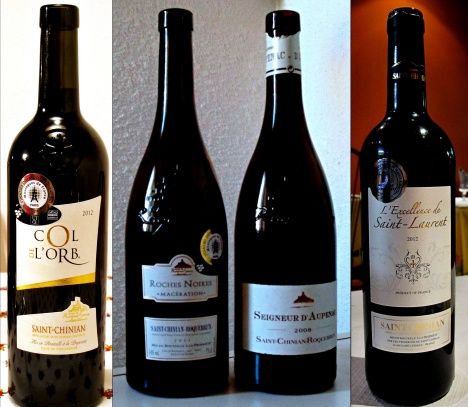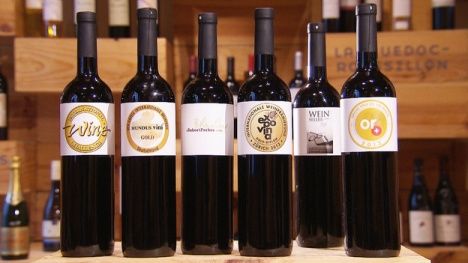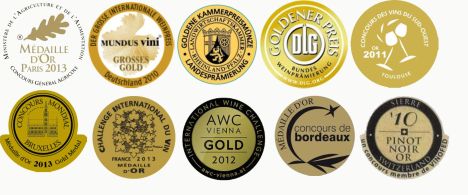Never before have I drunk so many wines crowned with gold and silver in such a short time. For two or three weeks I was "only" looking for simple but good everyday wines; wines that cost around 7 to 10 euros. It is the upper segment of the average wine drinker who usually buys his wines in the shop or even at the discounter. So my excursion did not take me to those wine shops where the most prestigious wine regions are represented, where people have long since stopped talking about gold and silver, but rather about the (too) high prices. The wines don't need silver and gold confirmations there, they themselves have long since been silver-plated and gold-plated in terms of price. But the old folk and student song "Gold und Silber lieb ich sehr..." (I love gold and silver very much) is not so unrealistic, at least as it continues: "...könnt ich gut gebrauchen, hätt ich doch ein ganzes Meer, mich hinein zu tauchen..." (I could do with a whole sea to dive into). In the meantime I am convinced: This sea of gold and silver has long existed, also in the wine scene. Otherwise, it is not possible that two out of three wines I looked for and drank in my search for lesser-known names, wineries and wines had at least silver, often even gold, to show for it.
 |
| In search of good wines for the "Drunk" section (Photo: P. Züllig) |
Coincidence or marketing strategy? Actually, I was looking for good, authentic wines full of character, wines that stood out above the average. And they did, the wines I found and drank, the vast majority of them. But whether they deserve the gold or silver nobility, I dare to doubt. That's just how competitions work: There are winners and losers, gold, silver and bronze. Because many (actually all) want to be winners, there are also an incredible number of opportunities to win. In sport as well as on the wine tasting floor. Examples in the nearer wine world: Mundus Vini, La Sélection, Concours Général Agricole Paris, Concours de Bordeaux de Vins d'Aquitaine, Concours Mondial de Bruxelles, Concours Général de Macors, Concours International Vins de Montagne, Grand Concours Vins d'Alsace... These are just a few examples, important and insignificant, a colourful mix... And so gold and silver also mix, almost arbitrarily, and present themselves full of splendour in the wine scene. This glamour tends to be smiled at or even rejected by "true" wine lovers. Not all wine drinkers - no matter how much they enjoy drinking good wine - have elementary expertise, sensory confidence or even modest knowledge of individual wine regions. It is all so complicated. Who is not dependent on - indeed, eager for - every hint that makes it possible to distinguish the extraordinary from the ordinary? Medals, whether gold or silver, from whomsoever, can be a clue, especially since gold and silver - wherever we go - are associated with legends and myths of all kinds.
 |
| Wines crowned with medals in the SRF programme "Kassensturz" (Photo: Swiss Television) |
For the Incas, gold was the sweat of the sun, for the Egyptians a divine sign (god Seth), and for the Romans, Jupiter appeared in a golden halo. What is anchored in the myths has been preserved at least in the attitude towards gold and silver until today, as a symbol of highest spiritual and material values: the golden sphere as a sign of unrestricted rule, the golden rings as a sign of loyalty, the golden hair ("so beautiful that its like is no longer to be found on earth"), the sunken gold in wells and lakes, in the fields or in the mountains, usually guarded by evil forces. Silver is no less entwined with legends and myths: from the poor farmer near Quedlinburg who sends his daughter into the forest in the bitterly cold winter to collect wood, and she then comes home with two baskets of silver - to the thirty pieces of silver of betrayal that were finally brought to the blood-soil.
The wine scene is particularly
prone to myths and legends: "Behold, how the golden wine flashes, here in my cup; hark, how sounds so silver-pure glad song of the revelers!" They are hardly "wild revelers" any more, but well-mannered wine drinkers who have long since exchanged the cup for the glass, who still dream of the golden or silver shine, of the myth that is hidden in wine and of which they say that truth lies therein.
It may be that I've just made it all up: the myth of gold and silver, the victor's staircase with the three pedestals. The fact is that an incredible number of wine competitions play with these tributes. At the international wine award "Mundus Vini" alone (one of the biggest competitions), about 6,000 wines are submitted every year, which are examined by 150 jurors. According to the regulations, a maximum of one third of the wines may be awarded prizes. In purely mathematical terms, this means that (if the quota is exhausted) 2,000 wines are awarded gold or silver. In this one competition alone. There are an incredible number of similar "competitions" in all areas of wine production, in all regions, for all grape varieties and in all price segments.
One rightly asks: what is a medal still worth? Many of the most renowned winemakers do not even take part in such competitions. Moreover, the decision-making criteria are often not clear (or uniform) and the jury compositions are just as often controversial. In the vast majority of cases, no bronze medals are awarded either, only gold and silver.
 |
| Parade of medals (Photo: P. Züllig) |
The already cited "Mundus Vini" competition - for example - increases the number of gold medals by awarding no more than about 30 per cent of the wines in total (as prescribed by the regulations), but two categories of gold are to be won: the "Grand Gold" and the "Gold" along with the silver (there is no bronze here either). In this way, the winners' rostrum is visibly gilded. Other competitions know similar tricks, which are hardly transparent and get lost in the multitude of categories. The consumer only sees the medal sparkling on the bottle; it is difficult to read on the medal which of the "concours" (the French term is very popular) it is. It doesn't really matter: the main thing is that the wine is crowned, that is, it stands out far above the average.
Sometimes even wines appear that are only pressed and bottled for a competition. Mostly with fantasy names of wines and wineries, often so-called merchant bottlings, created for the gold- and silver-believing market. It has long since ceased to be sufficient to document the quality of a wine only with scores (most famous: Parker points), stars or glasses. The test conditions are too different, the criteria are often too diffuse, and for the layman there is a confusion of points that is hard to understand.
Gold and silver are much better: "But one thing is wonderful to me until this hour, that the early morning brings gold in the mouth. Day is indeed a king's son, but the silver cradle, the sun, his golden crown, adorns him as if for victory." To all the "sunny" wines that already wear or will wear this crown. The consumer may at least dream of the (often so deceptive) golden heights.
Yours/Yours